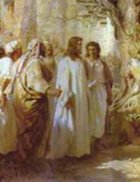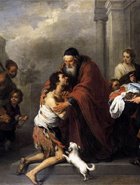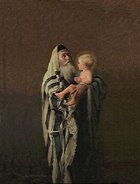The Second Century Dilemma

.... Paul’s epistle to the Colossians helped settle the issues that were in Colossae, Hierapolis and Laodicea over the true nature of the Godhead. But as the door of faith opened wider to the Gentiles, and the true beliefs of Christianity continued in confronting the old pagan ways, this sort of problem arose repeatedly until it became a plague on the church. Over the generations that followed, the controversy evolved to an inner-church form, mixing human reasoning with novel Scriptural interpretations to reach similar conclusions. It became of paramount importance for the church to right itself and define the Godhead doctrinally.
.... By the second century, Christians were studying the Scripture diligently over this question. What sort of a being is God? What does the Bible have to say when it is talking about God Himself, His very Person? They referenced the writing of the apostles and the Old Testament prophets, and their early research branched into two directions.
.... The first direction would lead to the Doctrine of the Trinity as we know it today. They began to see three Beings referred to in Scripture as ‘God’ (the Father, the Son, and the Holy Ghost), and yet the Scriptures also declared emphatically that there is only one God. This presented an enigma: Somehow, those three must be one-and-the-same in regard to essence, though retaining the personal distinctions that were attributed to each of them.
.... It was also during the second century that the term ‘Trinity’ first appeared in describing the Person of God, though the doctrine itself remained under study and would not be officially adopted by the church until the fourth century. So literally centuries of research, generations of carefully debated study, and also courage unbounded in the face of ceaseless imperial persecutions and torture, went into the founding of this doctrine – and this process led to its nearly universal acceptance in church in the end.
.... So if you ever hear one of the Trinity’s opponents telling you that the Doctrine of the Trinity was simply based on superstition, or that it came from the ignorance of the people, or that it was based on some sort of political expediency of the time – O, brother! Tell them to go back and read their history books! Not that we’re trying to be rough with them, but if they’re going to affirm these things to be so then they really ought to know more of what they’re talking about.
.... Anyway, leaving that aside for now, let’s remember that there were two branches of study that were underway in those days. Now let’s take a look at the other branch and their own conclusions about the Godhead; and to do this, let’s recall the situation by which all of this research was necessitated in the first place. It was because the pagans were trying to bring polytheism into Christianity.
.... The old pagan world view would have seen the Father, Son and Holy Ghost as three separate gods, according to the traditions of men, according to the basic principles of this world, and not according to Christ. Christians in both branches of research saw that this sort of thinking was wrong and knew they had to fight against it; and in order to do this, they had to know the truth about the Godhead.
.... Now one branch of research would lead to the Doctrine of the Trinity, which we’ve already discussed. But the other branch was developed by men like Origen of Alexandria, Lucian of Antioch, Paul of Samosata, or Eusebius of Nicomedia, and was later championed by a man named Arius, a Libyan who had relocated to Alexandria. Thus, history recalls him as Arius of Alexandria. Since Arius became the fervent, popular voice of this viewpoint within the church, historians have named this body of doctrine after him rather than his predecessors. This episode is referred to as "the Arian controversy" and his doctrines as "the Arian heresies".
















0 Comments:
Post a Comment
<< Home